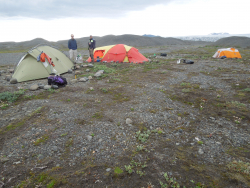Update
PolarConnect Event now archived
Jamie and team hosted a LIVE event from the field on Wednesday, 7 August 2013. This event is now archived and can be viewed here.
What Are They Doing?

The research team collected intact till (rocks and finely ground material picked up by a glacier, and deposited as sediment along its path) samples from the drumlins and the surrounding area. The samples were taken back to Iowa State University and the University of Wisconsin Milwaukee and subjected to geotechnical tests and magnetic fabric analyses. This testing determined the former distribution of stresses on the till and patterns of subglacial till deformation that were likely central to the formation of the drumlins. In addition to helping determine the internal structure of drumlins and how drumlins form, this research will shed light on the distribution of basal drag beneath glaciers—an important and poorly understood factor in their dynamics.
Where Are They?

The team camped just inside the outermost surge moraine of the outlet glacier, Múlajökul, about 2 km from the glacier margin. High winds and rain are common in the area. The group lived in tents and shared a large cook tent for meal preparation. The work required considerable hiking, fording of shallow streams, and digging in wet and cold conditions.
Latest Journals

Neal Iverson is the Smith Family Foundation Chair of the Department of Geological and Atmospheric Sciences at Iowa State University. His research is devoted primarily to understanding glaciers and the spectacular imprint they leave on the landscape. Glacier dynamics and landscape modification are particularly sensitive to processes at glacier beds, which is the focus of much of his effort.
This research involves field experiments at modern glaciers, field measurements in formerly glaciated landscapes, laboratory experiments, and the formulation of models aimed at characterizing glacial processes. He and some of his former students are the 2012 recipients of the Kirk Bryan Award, given by the Geological Society of America for research that advances the field of geomorphology. More information about Dr. Iverson can be found here

After receiving his PhD in geology and geophysics from Iowa State University in 1999, Tom Hooyer joined the Wisconsin Geological and Natural History Survey in Madison, Wisconsin where he primarily mapped glacial deposits and landforms from the last great ice sheet to cover North America. Tom recently moved to Milwaukee where he is an associate professor of geology at the University of Wisconsin – Milwaukee.
His research interests include glacier erosion, basal till deformation beneath ice sheets, and the Quaternary history of Wisconsin. Current research projects include field studies of fabric development of drumlins in Wisconsin and Iceland, bedrock erosion in Canada and Switzerland, and the mapping of Quaternary deposits in Wisconsin. Complimentary laboratory studies include using a ring-shear device to examine the particle and magnetic fabrics of sheared basal till. More information about Dr. Hooyer can be found here.




